How can Space Invaders Invade Your Space? The Epoch TV Vader!
Space Invaders is an epochal moment in video games. Arguably the first true megahit, it’s credited with starting the shoot ‘em up genre, making Japan obsessed with video games, popularizing the Atari 2600, and even making its way into Unicode: 👾. And an epochal moment deserves an Epoch of its own. Let’s go back into the well of single-game consoles.
Challenging Stage… wait wrong game
But first, let’s take a look at what makes Space Invaders particularly hard to recreate. See, while Space Invaders wasn’t the first game to run on a CPU instead of pure discrete logic (like Pong and Breakout had), it was a perfect example of a game that really needed that sort of technology.
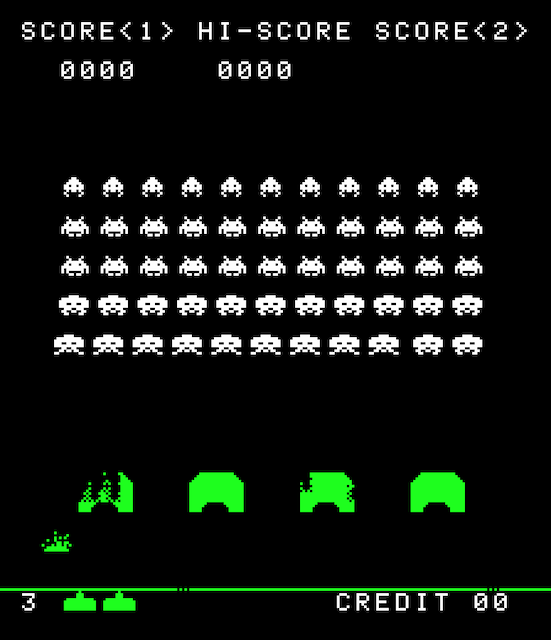
Well, yes, a discrete logic board can do anything a CPU-based board can do; you can make a CPU out of discrete logic. But let’s face it: Space Invaders is wholly a creature of the CPU generation. You have a whopping sixty invaders; unlike the stationary lines of Breakout, they all have their own animations and movement. The movement changes as you kill them; you can kill lines on the sides of the screen to increase their path, and they speed up– a natural consequence of the CPU having more time to do work.
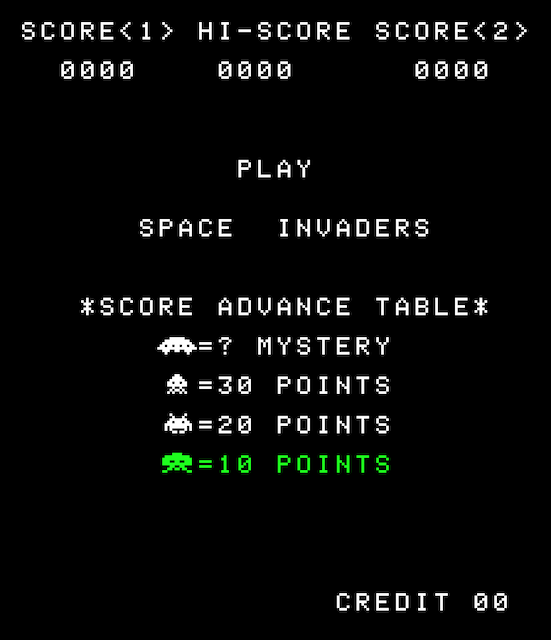
The Intel 8080-based arcade hardware was top of the line in its day, even if it seems primitive by the standards of what came later; a simple monochrome framebuffer, each bit corresponding to an on-screen pixel. Some fancy shift registers made it a little more tolerable to move things around, but you won’t find any concepts like “sprites” or “tilemaps” here, and certainly not a blitter. But the computing power of the Intel 8080 blew away the purpose-built circuits that came before it.

The Atari 2600 was able to replicate some of this. Fewer invaders, but it still played reasonably well– well enough that being able to play a decent Space Invaders really made the console kick off. And that wouldn’t come out until 1981, three years after the arcade release. This is an impressive beast for the 2600, which doesn’t have a framebuffer and very limited RAM, but it’s still a 6502-based console. That is to say, a real CPU.
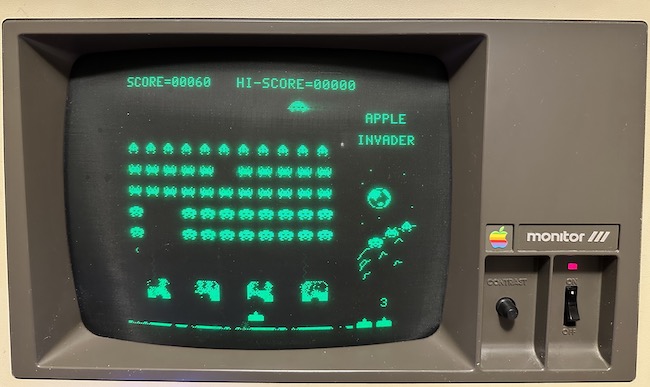
The Apple ][ could also play a nice game of Space Invaders. Given this unofficial port’s, Super Invaders or Apple Invaders, particular popularity in Japan, it’s probably more likely than not that any given J-Plus has played it at some point. The Apple ][ doesn’t have the shifter hardware, and it’s laid out a bit weirdly in memory, but HIRES mode is a frame buffer, so it’s not completely different.
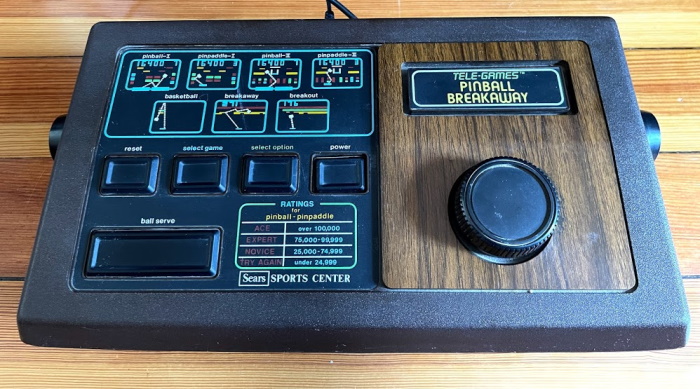
But what were people playing at home in 1980? The Atari 2600 wasn’t super popular, and certainly most people didn’t have an Apple ][. They were playing single-game consoles, like the Sears Pinball Breakaway. Well, as it turns out, the single game consoles were undergoing a revolution too. Early games like Home Pong or the clones based on the AY-3-8500 used very similar discrete logic as to arcade Pong, just consolidated onto a single chip. But the new generation, likely (not confirmed) including the Pinball Breakaway and Pong games based on MOS’ 7600 series (confirmed), were microcontroller based.

And Epoch, a toy company known for their LCD games and for bringing Pong clones (and later, the 2600!) to Japan, brought Space Invaders to this new platform. Well, I should say, TV Vader. Any resemblance to Taito intellectual property, just like with the 👾 emoji, is surely completely coincidental.
TV Vader

The TV Vader is a cute little device, though the ergonomics leave something to be desired. I’m not sure why they decided to put the fire button behind the joystick. You might be surprised there is a joystick– over here in the west, where Bally-Midway was the licensee, Space Invaders generally used buttons to move left and right:
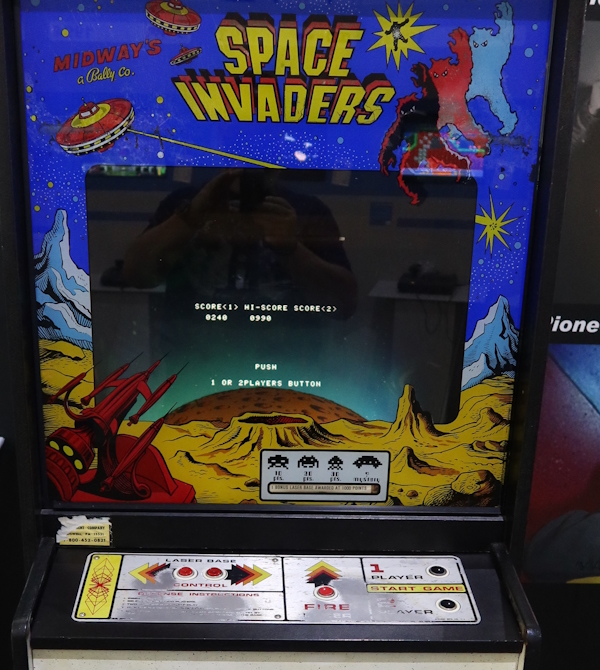
But this wasn’t true in Japan, where Taito-made cabinets, especially the extremely popular cocktail tables, used joysticks restricted to two-dimensional motion. So when you see modern recreations with a joystick, that’s not that weird. To the license-owners at Taito, it’s more authentic that way.
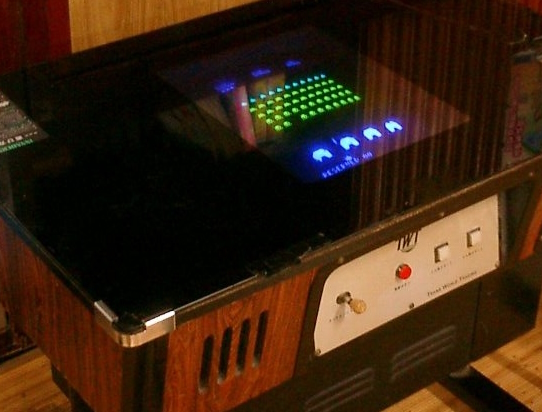
One thing I will say about TV Vader is that this particular one was used a lot. You probably can’t tell in this picture, but I spent an entire “magic eraser” melamine sponge cleaning off grime and dirt, especially where someone would rest their hands.

The back of the box shows off the gameplay, and a major feature of this device: unlike most of the arcade Space Invaders boards, this game is in full color. However, note well:

This screenshot is a lie. (Or shall we say, a composition)
Gameplay
So I told you that a more advanced architecture was required to play Space Invaders than previous Pong variants. And that’s true. But despite its advanced-for-the-time hardware (which we’ll discuss soon), TV Vader can’t actually match it’s 8080-based source material.
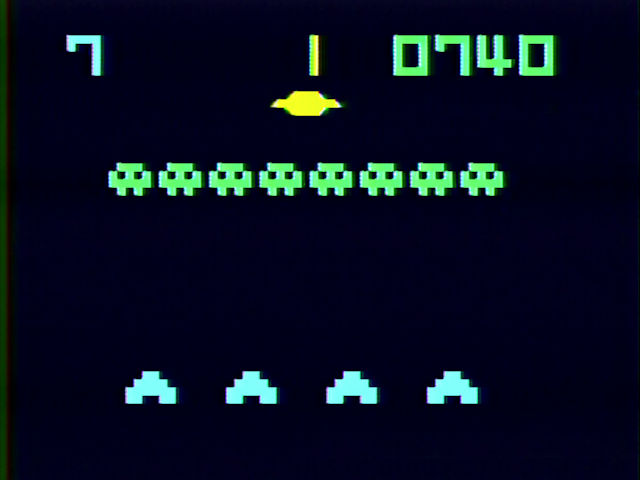
TV Vader can only actually show a single row of invaders at once (but in color!), in addition to the destructable bases and a mothership at the top. Now, the full set of invaders does exist: when you kill an invader, the invader behind it is revealed, as if it was hiding behind its counterpart. Color is used to distinguish them; the screenshot above is taken from the start of the game, where it shows all the rows one at a time.
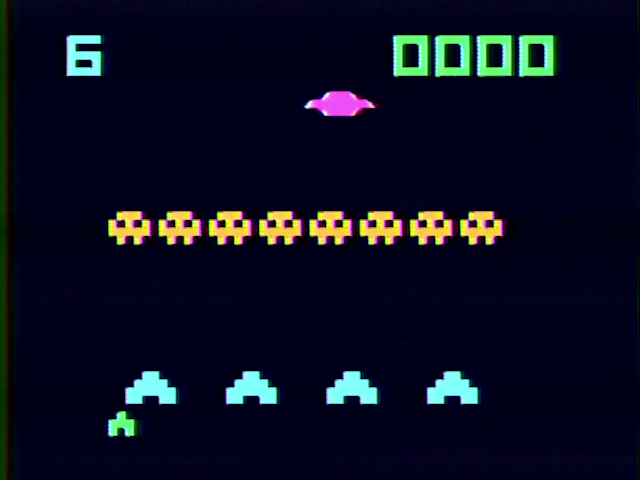
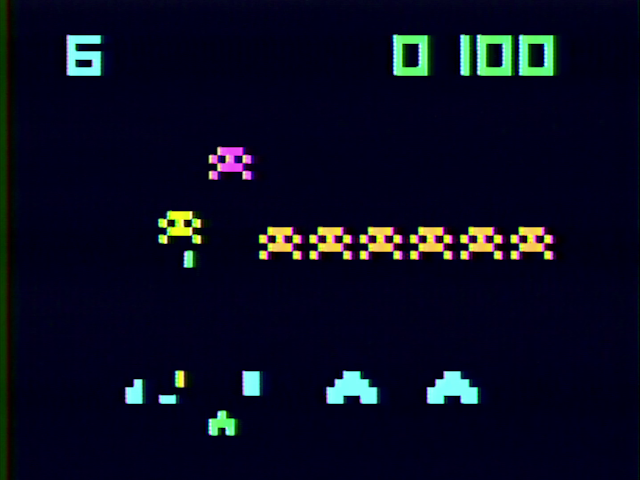
This is kind of a bummer, because it means you can’t use a carefully targeted trick shot to destroy an enemy behind the front enemy, which you can do in the arcade title.
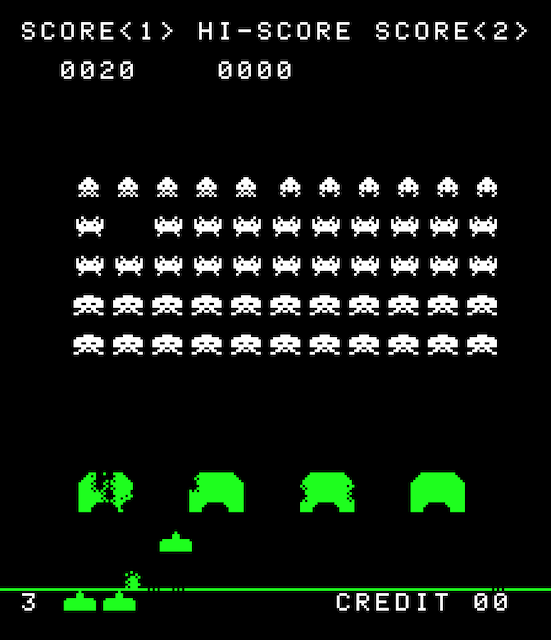
We actually have a nice interview with a supervisor at Epoch, Masayuki Horie, translated by the folks at Shmuplations. Big thanks to them for letting me reproduce this portion; go read the whole thing though, it’s a really interesting glimpse at the development process at the time.
Interviewer: Moving into the 80s, Epoch released TV Vader. Finally, I could buy a copy of Space Invaders for myself! (laughs) My copy went “on-tour” as I took it to all my different friend’s houses. (laughs) Everyone was crazy about it, although it only had 8 invader enemies on-screen at a time.
Horie: That was due to the sprite limits. The architecture at this time wasn’t so much about the number of sprites you could have on an individual line at once (like the Famicom), but more simply about how many you could have on-screen at once.
It was a real challenge. That’s why we had that excuse, that there were “invisible invaders” hiding behind those first 8. (laughs)
Interviewer: I remember that. (laughs) Maybe that wasn’t the best decision, in retrospect. (laughs) Maybe if you had said they were retreating when they get hit by the bullets, it would have gone over better. To a kid’s mind, I mean. (laughs) The illustration on the backside of the box showed 48 invaders, so it was a bitter pill to swallow. (laughs)
Horie: Well, for all the technical limitations we had, I think we made something that captured the essence of Space Invaders…
Mr. Horie isn’t wrong. The rest of the functionality is there. Destructable bases respawn a few times to make up for the fact that their pixels are so much bigger. Enemies move faster the more you kill (and it does take the total number into account), and there is a mothership occasionally passing by. In fact, when you kill all invaders, the mothership shows up again, doing some aggressive movements, which might be one of the earliest uses of a “boss” in shoot ‘em ups.

Fair warning to those who want to pick up this game but are photosensitive: because this is an early title, it flashes the screen bright pink when you die.

What’s inside
So, when we pop open the device, we can immediately tell this wasn’t sold in the United States: contemporary FCC regulations required aggressive shielding, especially for anything that broadcast over licensed frequencies (which includes the television frequencies used by the RF modulator). Since this was sold in Japan, that doesn’t matter.
Another thing you won’t see is a power regulator. This takes 6V input, center-negative; since this goes to the chips directly, using a good-quality power supply is a must. My machine didn’t come with a power supply; I’m using a Triad WSU060-1250-R. I’m a little surprised that with the 6V requirement and so much empty space in the case it doesn’t have battery options, which is common in single-game consoles. (6V being a multiple of 1.5V, a standard voltage for batteries)

That chip with the heatsink is the RF modulator, an NEC µPC626C, very similar to the National Semiconductor LM1889 (used in, among other things, the ColecoVision). The other chip, the NEC µPD774C, does everything else. And usually, that would be about it that I could say for a device like this. I don’t have the capacity to decap chips like this, which would be the only way to get documentation.
But here’s the amazing thing about the NEC µPD777-series (as this group of single-game chips is known): hardware designer Tetsuji Oguchi has posted huge amounts of technical detail on his website, including a die shot. And a lot of it is in English.
For example, we can take a look at the 777 Design Note to find that the internal program ROM uses a polynomial address counter, not a linear one. (Saving transistors!) The screen is 75x60 dots with 7x7 objects (“patterns”) stored in a separate internal pattern ROM.
These patterns are not quite sprites in the modern sense, but can interact with the screen in a number of ways, which Mr. Oguchi documents in his JIEC seminar.

You probably noticed that while the pixels are quite large, the mothership has angular sides that don’t fit the pixel grid. Not only does Mr. Oguchi document this “bent mode”, he describes exactly how it was used to create the mothership in TV Vader specifically, bending two patterns left and right and then overlapping them.
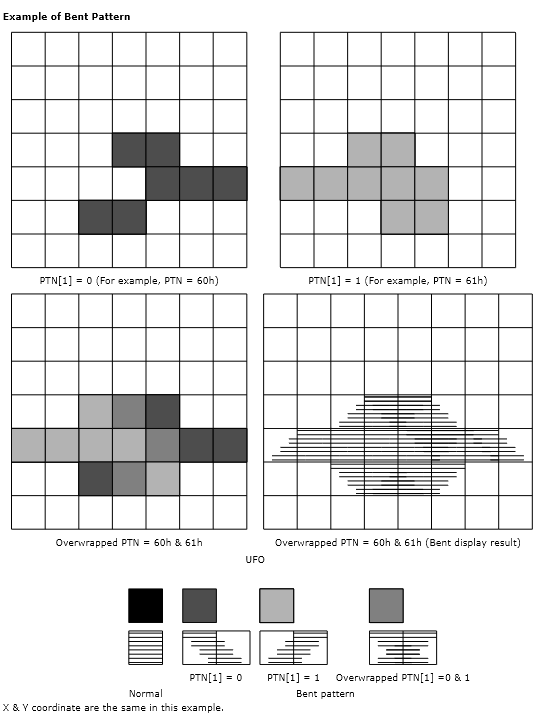
So a huge thanks to Mr. Oguchi for posting all this information online. Clearly his group at NEC were major pioneers in the electronics industry (they followed up the 777 series with the famously capable µPD7220) and I’m glad he’s documented their work for future generations like mine to see. I’m really just scratching the surface of what he’s posted; regular readers of Nicole Express might want to see his 777 to YUV high resolution graphics output, for example.
The future
One thing you’ll notice from both the interview with Mr. Horie from Epoch or from Mr. Oguchi’s website is that the 777 series wasn’t just used in standalone consoles like the TV Vader. It formed the basis for a video game console that straddled the line between first-generation game-on-a-chip and second-generation cartridge based systems.
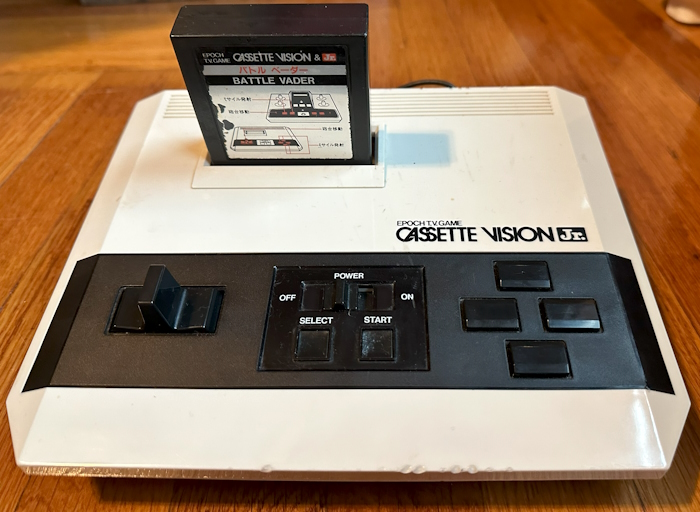
Look forward to it!
